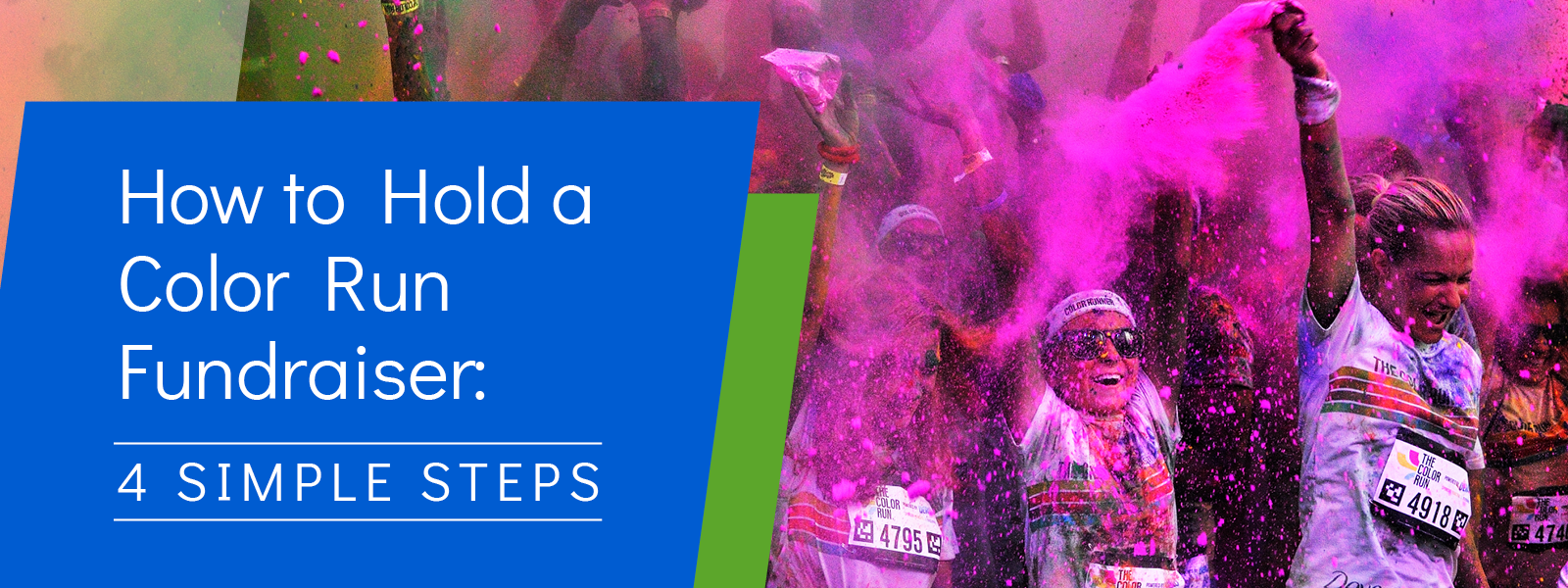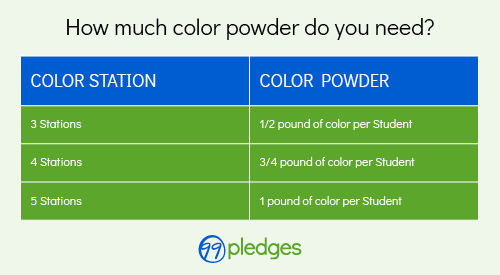
Fundraising is a crucial part of managing any organization and keeping operations running. Nonprofits need donations to power their projects and further their missions, and schools often need to fundraise to purchase school supplies and provide enriching educational experiences to students.
If you’re looking for a compelling event to supercharge your fundraising efforts, color run fundraisers are a simple, low-cost way for any organization to raise money. They’re a fantastic way to bring your community together in support of your cause. Plus, they can be used to raise money for anything from your school’s band program to your soccer team. In this guide, we’ll walk through what you need to know how about holding a color run fundraiser:
- What is a color run fundraiser?
- How can you organize a color run fundraiser?
- What are some helpful tips for setting up a color run fundraiser?
Because color run fundraisers are so easy and affordable to set up, they are a great option for parents and teachers looking to fundraise for their students’ school. Not only are color runs exciting, but participating is simple for kids in many different age groups. Not to mention, they’re a fantastic way to promote a healthy lifestyle and to get students up and moving! Let’s dive into everything you’ll need to know to get started.

What is a color run fundraiser?
A color run fundraiser is similar to a traditional 5K or 10K fundraiser—but it has its own fun twist. As participants run the race, volunteers douse them in colorful powder.
To raise money, you can apply the pledge drive fundraising model to your color run. Essentially, students will sign up to participate in the race and then collect donations from their friends and family. Supporters will pledge to donate a given amount for each kilometer or mile the students run during the event. After the race, students tally up the distance they ran, report back to donors, and collect the donations for your color run.
Because managing so many different donors from your participants can be difficult to juggle, it’s best to work with a fundraising platform that can help you facilitate the event. For example, if you partner with 99Pledges, you can:
- Raise more through personal student donation pages that don’t require parent set-up.
- Reduce the work you have to do because you won’t need to chase down checks or pledge forms.
- Keep more funds with no credit card fees, set-up, minimums, or charges to donors.
- Be supported by working with a team that does all of the set-up for you and can help every step of the way.
Using a fundraising platform can also help PTA members avoid the tedious or stressful parts of fundraising that might cause burnout—like tracking down late donations or recovering lost paper donation forms from students. With a platform that handles the details, organizers can get back to the fun parts of organizing the event and getting students excited about the race.

How can you organize a color run fundraiser?

Step 1: Choose a date, time, and location.
These important logistical details should be one of the first things your PTA irons out when planning a color run fundraiser. Be sure to start planning well in advance. That way, you’ll have plenty of time to spread the word about the race and account for any bumps in the road.
As your PTA narrows down the fundraiser’s details, keep these logistical elements in mind:
- Date. If you’ve ever organized a walk-a-thon or charity 5K, you know how important it is to be mindful of the weather, holidays, and your participants’ schedules when choosing a date. If the event is primarily for students, scheduling it on a Friday afternoon is a great way to generate excitement at school. However, if you want your students’ families to attend as spectators, try to schedule the race around traditional work schedules.
- Time. Like the date you choose, start the race at a time that makes sense for your participants. If you choose to host your fundraiser over the weekend, it might be best to kick off the event earlier in the day so families can still have time to do any other activities they have planned.
- Location. The location you choose needs to be large enough for your participants to run the race’s complete distance and accepting of the messy nature of a color run. A great option for schools is to use the track so students don’t need transportation off campus.
While these details might seem small or insignificant at first glance, they can dictate the overall turnout at your fundraiser. Strive to choose a date, time, and location that fits into the average student’s schedule so everyone who wants to attend can.

Step 2: Gather supplies.
The most essential item you’ll need during your school’s fundraiser is the color. Most schools and other organizations that hold color run fundraisers choose to use colorful powder that participants can easily brush off after the race rather than paint. The powder is also easier to clean up once the race is over.
Depending on the length of the course, a typical color run course has about five or six stations set up where volunteers will throw colorful powder at participants as they run by. Here’s what you’ll need at each station:
- Two to three volunteers
- A small table
- Buckets of color powder, usually one per station
- Cups or condiment bottles for throwing the powder
- Water for thirsty runners
The number of participants you have at your race can influence how many stations and volunteers you need on deck, as well as how much colorful powder you need to purchase. Here is a quick guide you can use to calculate how much powder you’ll need:

- If you have three color stations, you’ll need half a pound of color powder per student.
- If you have four color stations, you’ll need three-fourths of a pound of color powder per student.
- If you have five color stations, you’ll need one pound of color powder per student.
Keep in mind that these are rough guidelines you can use to determine how much color powder you need to purchase before the fundraiser begins. You can adjust the amounts depending on your school’s budget or how covered students you want students to be.

Step 3: Hold the color run fundraiser.
Next, you need to hold your color run fundraiser! For most of the event, you can sit back and watch runners enjoy the race as your volunteers occasionally throw colored powder their way. But, you should also brainstorm ways to make the beginning and end of the race exciting for runners—you might even add something like bubbles or foam in at the end for a big finale.
A color toss is a great way to kick off and wrap up the race. To do a color toss, gather your runners together and toss the colored powder in the air so it rains down on everyone. You can either gather all of your volunteers at the starting and finish lines of the race to toss the large amounts of powder or allow participants to grab handfuls of powder up themselves. To increase participation in the fundraiser, consider allowing spectators to join in on the final color toss if they make a small donation.

Step 4: Clean up.
Cleaning up after your fundraising is fairly simple, and with a strong team of volunteers, you can finish cleaning up in no time. You’ll just need to sweep up as much color as possible with a broom and dispose of it in the trash. The remaining color will leave no more than a sidewalk chalk-like residue you can easily wash away with water.
Make sure to share some clean-up instructions with parents before and after the event. Parents should bring towels to place in their car for after the race so none of the powder transfers to their car seats. Most of the time, the color powder will dust off of clothes and rinse out in the wash, and a shower will remove it from hair and skin.

What are some helpful tips for setting up a color run fundraiser?
Setting up a color run fundraiser is a very simple process, but you might still have some questions about the best way to optimize the experience for participants. Here are a few tips to consider as you organize your fundraiser:
- Engineer your starting line. Starting lines can quickly get congested if everyone takes off at once, especially if you have several participants. To cut down on starting line traffic jams, divide runners into groups of ten to twenty-five people and release each group in waves—ideally waiting about 90 seconds between each wave.
- Capture memories. Make sure to station volunteers with cameras ready throughout the color run route. Prioritize snapping pictures at the finish line when participants are completing the run and covered from head to toe in colorful powder.
- Set up a blowoff station. At the end of the race, participants will be powdered in colorful dust (which is the goal!). Give them a chance to clean off before hopping into their cars at the end of the fundraiser by setting up a few high-powered fans at the end of the race.
- Make it entertaining. The key to motivating your participants to try their best and finish strong is to amp up the energy at your color run. Play music during the event to entertain runners and spectators.
Keep in mind that you might need to make some additional considerations based on the size of your school’s event. For example, let’s say hundreds of people are attending. In that case, you’ll need to make sure your color run course is long and wide enough to accommodate all participants. For even larger events, you’ll also need to recruit more volunteers to toss color powder, take photos, and pass out water.
Additional Resources
A color run fundraiser can help your school raise money to enrich your students’ educational opportunities. Not only is this fundraising idea low-cost and easy to organize, but it’s also exciting and fun for students.
Don’t forget to find a school fundraising platform you can use to simplify the donation collection process! Having the right technology in place will help your parents, teachers, and students alike focus on enjoying the race, rather than stressing over collecting donations.
If you want to learn more about fundraising for your school, check out these additional resources:
- How to Organize a Fun Run Fundraiser in 7 Steps. Fun runs are another great way to get participants outside. Check out this step-by-step guide and learn how to host your own fun run.
- 15 Profitable Football Fundraising Ideas for Your Team. Your student’s time on the football team should be an enriching experience. Learn how you can use fundraising to offer them those experiences.
- 10+ Simple Soccer Fundraising Ideas for Your Team. As a parent or coach, you know how expensive playing soccer can be. These fundraisers can help you raise the funds your team needs to succeed.

